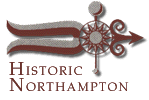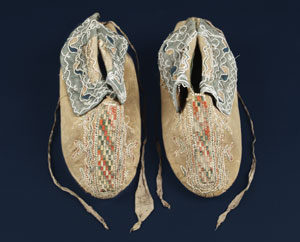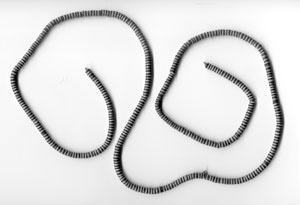
Archives & Manuscripts Costumes & Textiles Daguerreotypes & Photographs Decorative Arts Fine Art Other Collections Furniture Digital Collections 
|


Moccasins
 |
Photograph by Stan Sherer |
This pair of moccasins represents a fusion of native technology and European style. The lining is cotton tape and the ties are silk, both trade goods. The porcupine quill embroidery is executed with traditional techniques, but the design of a meandering vine and flowers probably derives from European embroidery patterns.
The moccasins were donated to Historic Northampton by Martha Woodruff and Mrs. Mary Breaker. According to the donors, the moccasins belonged to Mathew Woodruff who emigrated from England to Boston in 1636. Woodruff also lived in Farmington, Connecticut. The donors believe Woodruff may have died in 1682.
 |
Wampum, circa 1660 Gift of Martha Woodruff |
No other single aspect of Indian material culture attracted as much of the attention of Europeans as wampum. There is some controversy among historians and anthropologists regarding the exact origins and functions of wampum before contact with white traders, but the available historical and archaeological evidence strongly suggests that it was not widely produced before the fur trade was established and that it performed restricted functions, such as in the regalia of sachems and in treaty negotiations in the form of belts. Only after white traders discovered that wampum woven in standard lengths could be used as a currency unit in the fur trade did various coastal tribes begin to increase production of wampum, and the control of the centers of production became the underlying issue in power struggles between tribes and between various groups of whites interested in controlling the tribes.
 |
Chair belonging to Sally Maminash |
The inscription on Sally Maminash's gravestone in the Bridge Street Cemetery reads:
SALLY MAMINASH The last of the Indians here A niece of Occum. A Christian. Died in the family of Warham & Sophia Clap Jan. 3. 1853. Aged 88. |
This epitaph tells much more about nineteenth-century New England than about Sally because she was not the only Native American Indian in Northampton and was certainly not the last. She was an accepted and skilled member of the local community, working as an itinerant spinner and weaver. Sally's mother, Elizabeth, came from the community of Mohegan in southeastern Connecticut. Her brother, Joseph Maminash, was a Revolutionary War veteran. Her uncle was Samson Occum, Mohegan preacher, fundraiser for Moor's Charity School (later Dartmouth College), and founder of the Brotherton Community of Christian Indians in New York. For further information, read Sally Maminash: Last of the Indians Here by Margaret Bruchac.
Contents Historic Northampton.